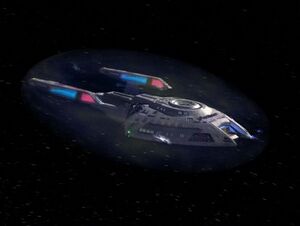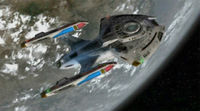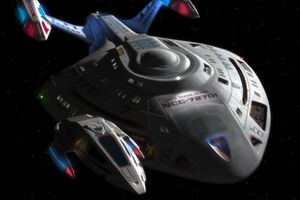Nova Class
The Nova-class was one of Starfleet's most advanced scientific vessels, emerging as a replacement for its predecessor, the Oberth-class, during the late 2360s.
Designed as a science and scout vessel, the Nova-class was used for short-term planetary research and analysis after a region had been surveyed by larger explorer-type vessels. It was not designed for long-range tactical missions.
Technical data[edit]

The Nova design had a maximum speed of warp 8 and, compared to other Starfleet vessels, minimal weaponry, limited to defensive phasers and torpedo launchers.
This class had a small crew complement of about 80.
One unique feature of the Nova-class was its Waverider shuttle, which was located in a special docking port on the ventral side of the primary hull, similar to that of the Aeroshuttle on the Intrepid-class.
Physical arrangement[edit]
The Nova-class had a design similar to that of an Intrepid-class starship, though half the size. It consisted of a saucer section with a curved triangular shape. The secondary hull was directly attached to the underside of the saucer with two warp nacelles.
Unlike some starship designs, the Nova-class only featured one impulse drive, located at the aft end of deck 2 aligned center to the ship.
Tactical systems[edit]

Though Nova-classes were science vessels, they had a wide assortment of weaponry, allowing the vessel to handle many threats on its own. It was equipped with eleven strategically-placed phaser arrays: eight on the saucer and three on the secondary hull, two forward-facing photon torpedo launchers at the bow of the saucer opposite of the secondary deflector, and one aft-facing launcher.
[edit]
In order to prevent space debris and objects from colliding and damaging the vessel, Nova-class vessels, like other Starfleet vessels, were equipped with a navigational deflector at the bow of the secondary hull. If the main deflector was damaged or disabled, a secondary deflector on the saucer could substitute the main deflector.
Like most Starfleet vessels, the Nova-class was also equipped with a deflector shield for defensive purposes. Shields on a Nova-class could be fully recharged after charging the shield emitters for 45 seconds. This task required the shields to be dropped. The shield grid itself was located along the secondary hull.
Landing and planetary flight[edit]
As a science vessel, Nova-classes had the ability to land on planetary surfaces utilizing four landing struts in the secondary hull. To further accommodate ease of research, Nova-class ships were designed to enter planetary atmospheres for long periods of time.
Interior design[edit]
Though a small ship, the Nova-class was able to accommodate the needs of the crew. This class of starship had eight decks.
Deck 1: Main bridge, Captain's ready room Deck 2: Impulse drive reactors, mess hall, crew quarters Deck 3: Cargo bays, deuterium tanks, transporter room, crew quarters Deck 4: Main shuttlebay, sickbay, escape pods, main computer core access, Waverider, auxiliary deflector, crew and officer quarters Deck 5: Docking ports, warp core access Deck 6: Main deflector Deck 7: Tractor beam emitters, main engineering Deck 8: Antimatter storage, landing struts
Main Bridge[edit]
The Main Bridge, located near the center of deck 1, was the command center for the ship. Despite the size of the ship, the spacious bridge allowed for the ease of movement between stations.
The central command area on the bridge was at the very center of the circular area in a submerged location. The captain's chair was starboard side, and the executive officer's was on the port side. Between them was a console built into the structure that provided a place for information dissemination, as well as operational command of the starship. Directly ahead of the command area and down into a further sunken area, was the conn.
The rest of the stations were located on the perimeter of the round bridge, including the master systems display behind the command seats and the main viewscreen in the standard frontwards position. Stations, such as Tactical, were not stand-out stations due to the scientific nature of the design. When necessary, Tactical would usually be assigned to the forward, port side console just right of the main viewscreen.
Entryways to the bridge were located at the port and starboard sides on the upper level. The port door leads to the main turbolift while the starboard door leads to a corridor that accesses other sections of deck 1. Access to the captain's ready room was also located on port side.
Main Engineering[edit]
Main engineering of the USS Equinox with warp core modificationsMain engineering was located on deck 7. The Nova-class engineering section only spanned one deck, and featured four wall based engineering consoles and a warp core analysis console in front of the core itself. At the far end of the room was the warp core with a transparent floor and support railing around it. The core spanned from decks 5-8 and could be ejected from the bottom of the ship through an ejection hatch. The core could be accessed from either engineering or from the maintenance areas around the core.
Sickbay and science labs[edit]
The Nova-class had one sickbay located on deck 4, in front of the shuttlebay. The Nova-class medical facility was equipped with an Emergency Medical Hologram system, like the one on USS Voyager.
Additionally, as a science vessel, the Nova-class was equipped with a number of specially-equipped science and research labs. The labs were similar to those found on an Intrepid-class vessel and served many purposes and supported numerous personnel. They featured a great number of work consoles to perform numerous tasks and had one main work console area in an alcove.
Auxiliary craft and cargo bays[edit]
Behind the main sickbay were two shuttle bays, which could contain a single shuttle each. In the saucer on deck 4, a short trip from the shuttle bays, was the aforementioned Waverider auxiliary craft, which was integrated into the Nova-class' hull. Spanning decks 2 and 3 in front of the shuttle bay were the main cargo bays which also contained Workbees, used for transportation and repair purposes.
Additionally, like a majority of starships in the 24th century, Nova-classes were equipped with emergency escape pods, twenty in total; fourteen were located on deck 3, four on deck 1 and two on deck 2, all located in the saucer section. They were stored under hatches to permit both launch and retrieval.
Crew quarters[edit]
Due to the size of this class, crew quarters were not luxurious but provide all the standard needs for the crew. A majority of the quarters were standard crew quarters, though a number of them were larger for use by the senior staff. The majority of these larger quarters were located on decks 1 and 4, with slightly smaller ones located on decks 2 and 6.
Specifications[edit]
- Type: Science vessel
- Length: 165 meters
- Beam: 81.2 meters
- Draft: 31.4 meters
- Mass: 110,000 metric tons
- Decks: 8
- Crew: 80
- Maximum Speed: Warp 8
- Armament: 11 phaser arrays, 3 photon torpedo launchers
- Defenses: Deflector shields
Civil War Modifications[edit]
Due to it's exceptional flexibilty the Nova Class vessel was selected to undergo a variety of variations by both sides. The most widespread was the Destroyer configurations. In which the number Phaser arrays were reduced and convereted to the Pulse Phaser configuration and an additional 3 torpedo bays were added. This Variation was also equipped with a cloaking device and the Newest Mark VI Quantum Torpedoes which had nearly twice the range of the Mark V.
- Type: Light Destroyer
- Length: 165 meters
- Beam: 81.2 meters
- Draft: 31.4 meters
- Mass: 110,000 metric tons
- Decks: 8
- Crew: 80
- Maximum Speed: Warp 8
- Armament: 6 pulse phaser arrays, 6 quantum torpedo launchers
- Defenses: Deflector shields
Future timelines[edit]

In an early 25th century alternate timeline, a variant of the Nova-class was in use. The interior of the ship was almost the same, however, the exterior had a number of changes. The variant also had superior tactical firepower and shield strength to that of its predecessor. In a later timeline, this class of vessel was still in use during the 26th century by the Federation and was involved in the pivotal Battle of Procyon V.
The Nova-class variant featured many changes, performance or visual-wise. Additions include a dome added to Bridge, impulse engines combined to one reactor on deck 1 and its auxiliary deflector reduced greatly, triangular shaped. The gap in front of it is filled in. Portions of the Bussard collectors were covered by hull plating and the dorsal intercoolers were reduced to one on each warp nacelle from two. Finally, the ship's escape pods were replaced with Sovereign-class pods.